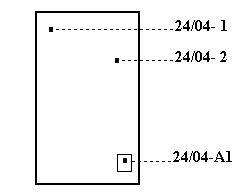
North Sea
Well Explorer > Site Properties or Well Properties > Location Description Tab
The North Sea system is the standard well identification system used in the United Kingdom, Netherlands and other North Sea countries. This Unique Well Identifier (UWI) format is a coded string containing seven components (a) - (g), which uniquely identifies each well. The format of this string is as follows:
(a) (b) / (c) (d) - (e) (f) (g)
Each portion of the string is represented as follows:
|
Component |
Position |
Description |
|
Country |
(a) |
One character code for the country in whose waters the well is drilled. |
|
Quadrant |
(b) |
The number, or letter, of the quadrant in which the well is drilled. |
|
Block |
(c) |
The number of the block within the quadrant in which the well is drilled. The number has 2 digits including a leading zero. |
|
Block Suffix |
(d) |
This component is used if the block is subdivided, usually after partial surrender, otherwise it is omitted. The retained part has the lower case suffix 'a' and the part(s) surrendered, which may be re-licensed, are given lower case suffixes 'b', 'c' etc. (See Relinquishment of Part Blocks - Effects On Well Numbers). |
|
Platform or Subsea Cluster Designation or land site |
(e) |
For wells drilled from a fixed or floating platform or through a subsea template or from a land grouping one capital letter should be used for platform designation, otherwise left blank. The letter S should not be used to avoid confusion with subsea wells in the PPRS. (See Extension Of 'Platform' Designation To Subsea Templates Etc. ). |
|
Well Sequence (drilling sequence number |
(f) |
The Drilling Sequence Number (DSN) is the consecutive chronological number of the well within the block or from the 'platform', consisting of up to two digits with no leading zero. The chronological sequence number will be allocated to the well only after it has commenced drilling to a specific bottom hole target location, as follows :
|
|
Well Suffix |
(g) |
(i) Re-spud If a well is re-spudded for any reason it is distinguished by an upper case character 'A', 'B', 'C', etc. in this component (not applicable to 'platform' development). A well is designated to be a respud when the original attempt to drill the well fails for any reason at or near the surface and another well must be started at a nearby surface location to drill to the same target. First respud has a capital A, second B and so on. (ii) Sidetrack If a well is sidetracked and the abandoned part of the hole has significant data (i.e. logs, MWD and/or core) the sidetrack is distinguished by 'Z', 'Y', 'X', etc. in this column. If a sidetrack is for mechanical reasons only and the abandoned part of the hole does not have significant data (i.e. logs, MWD and/or core) and is not through any known hydrocarbon bearing interval, then no suffix is required. Re-spudded wells which are then sidetracked have their 'A', 'B', 'C' etc. replaced by 'Z', 'Y', 'X', etc. Examples: 1st attempt 211/03b- 21 Respud 211/03b- 21A Mechanical sidetrack 1 (logged) 211/03b- 21Z Mechanical sidetrack 2 (cored) 211/03b- 21Y Geological sidetrack 211/03b- 21X (note there are four separate wells here) Multilateral wells will also be numbered in this way, with a suffix for each lateral. |
Relinquishment of Part Blocks - Effects On Well Numbers
Wells within a block will continue to be numbered consecutively even after the block has been subdivided for licensing purposes, (e.g. following partial surrender and subsequent relicensing). After subdivision, however, the block subdivision suffix (e.g. 24/04b) must be used.
The first well drilled from a platform will take the suffix applicable to the block or part block in which the platform resides when drilling commences. All wells subsequently drilled from that platform assume the same block suffix as the first well. Once drilling has commenced on a platform, relinquishment of part of a block will not require a change in platform wells numbers i.e. there will be no need to add a block suffix to the well registration number for existing or future wells drilled from that platform.
The following diagrams illustrate this:
Two exploration or appraisal wells 24/04- 1 and 24/04- 2 have been drilled in block 24/04 and one well, 24/04-A1 has been drilled from platform A.

Following relinquishment block 24/04 is subdivided into 24/04a and 24/04b.
The next exploration or appraisal well to be drilled in block 24/04 is in relicensed sub-block 24/04b and is numbered 24/04b- 3; the next one drilled in block 24/04 is in retained sub-block 24/04a and is numbered 24/04a- 4.
The next development well drilled from platform A is numbered 24/04-A2 because the first well had been spudded prior to relinquishment.
If a second platform B was to be located in sub-block 24/04a wells would be numbered 24/04a-B1 and so on.

Extension Of 'Platform' Designation To Subsea Templates Etc.
All subsea structures or templates through which two or more development wells may be drilled will be given a 'platform' designation letter (component e) and wells will be numbered (component f) like platform wells. A platform or other installation set above the template will adopt the template designation letter. Clusters of subsea development wells will be treated in the same way as templates.
Source References:
DTI Oil and Gas, "DTI Petroleum Operations Notice, No. 12 Department of Trade and Industry well numbering system", http://www.og.dti.gov.uk/regulation/pons/pon_12.htm (© Crown copyright 2001).